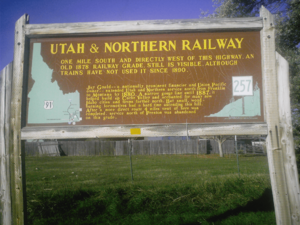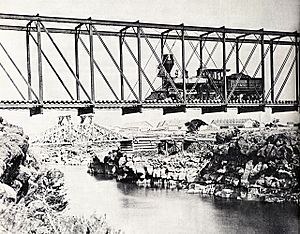Utah and Northern Railway facts for kids
| Overview | |
|---|---|
| Headquarters | Ogden, Utah |
| Locale | Ogden, Utah, to Butte, Montana |
| Dates of operation | 1871–1889 |
| Technical | |
| Track gauge | 4 ft 8 1⁄2 in (1,435 mm) standard gauge |
| Previous gauge | originally 3 ft (914 mm) gauge |

The Utah & Northern Railway was an important railroad that operated in the western United States during the 1870s and 1880s. It ran through what were then the Utah Territory, Idaho Territory, and Montana Territory. This railway was special because it was the very first railroad built in both Idaho and Montana. Today, parts of its original route are still used by the Union Pacific Railroad.
Contents
Building the First Sections
The first part of the Utah Northern Railroad was about 75 miles long. It was planned and built by members of the Mormon Church. This section was a narrow-gauge track, meaning the rails were closer together than standard tracks. It connected to the main Union Pacific Railroad line in Ogden, Utah.
Why Mormons Built Their Own Railroad
The main goal was to serve Mormon communities in the Cache Valley. Most of the work was done by Mormon volunteers. They built their own railroad because other companies weren't interested in building tracks to their settlements. They also wanted to transport goods without relying on the town of Corinne, Utah, which they felt was against them.
The railroad started being built north from Ogden on August 24, 1871. In three years, the volunteers built 75 miles of track. It reached Franklin, Idaho, in May 1874.
Challenges and Stopping Construction
Building stopped in Franklin because investors became worried after a financial crisis in 1873. Also, there were fewer Mormon volunteers in the northern part of Cache Valley. This area had only recently become open for settlement after agreements with the Shoshone and Bannock Native American tribes. Because of money problems and not enough business, the Utah Northern went bankrupt and was sold in 1878.
A New Start with Jay Gould
A powerful businessman named Jay Gould and the Union Pacific Railroad bought the Utah Northern. They changed its name to the Utah & Northern Railway. They invested a lot of money into the railroad.
Why Big Business Wanted the Railway
These big companies knew that electricity would become very important. This meant there would be a huge demand for copper. They knew there were rich copper mines near Butte, Montana. The Union Pacific quickly started building the railway again in April 1878.
Extending the Line to Butte
The new plan was to build a direct route through Cache Valley, then north across eastern Idaho and western Montana, all the way to Butte.
- In the first year, they reached Eagle Rock (now Idaho Falls, Idaho). They built a bridge over the Snake River there in early 1879.
- In the second year, they added 90 more miles of track. They also crossed the continental divide, which is a high point where rivers flow in different directions.
- By the end of 1881, after three and a half years of building, they finished the last 120 miles to Butte, Montana.
Butte became the biggest copper-producing city in the world! Its population grew to nearly 100,000 people. This made Butte, with its wealthy mine owners called "Copper Kings," the second-largest city in the West. It was even more important than cities like Salt Lake City or Denver. Butte was often called the "Pittsburg of the West" because of its large mining and metal-making operations.
Changing the Tracks
On July 25, 1887, the Utah & Northern changed its tracks. It switched from a narrow gauge (3 feet wide) to a standard gauge (4 feet 8.5 inches wide). This happened only six years after the line reached Butte. The railroad ran successfully for several years and eventually became a part of the Union Pacific Railroad.


